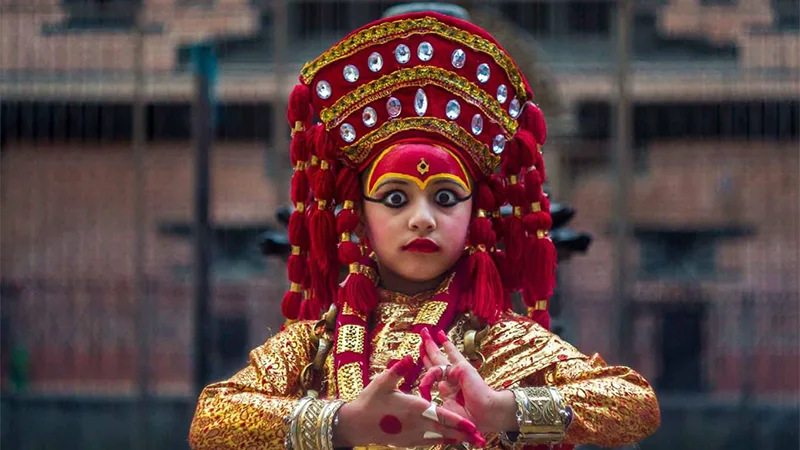The culture of worshiping Goddess Kumari in Nepal is very unique. It mixes Buddhism, Hinduism, and the native Newari culture. People in Nepal pray for young girls before puberty, as they regard them as manifestations of Devi, which signifies “divine female energy.” Kumari, or Kumari Devi is the name for this. A Goddess Kumari of Nepal: The only living goddess is chosen from the Shakya clan of the Nepalese Newari community.
The word Kumari translates as “virgin” in English. “Kumari,” on the other hand, comes from the Sanskrit word “Kaumarya,” which means “princess.” The Kumaris are young girls with the power of Goddess Kali and Taleju. It is said that the goddess Taleju is currently appearing as a Kumari goddess. Kumari is the goddess Taleju in human form. She stands for power and protection.
Patan, Bhaktapur, Bungmati, Thimi, and the other Newar towns have their own individual Kumaris. Kathmandu Kumari holds the title of Royal Kumari, making her the highest-ranking Kumari in the world. Like the selection of Tibetan lamas, a Kumari must go through a systematic procedure. A Malla ruler established the practice in the seventeenth century.
The historic Gaddi Baithak Hall in Basantapur, Kathmandu, is immediately adjacent to the well-known Kumari Temple. The construction of Kumari Ghar dates back to 1757, when King Jaya Prakash Malla undertook it. You can see the artistic skills of Nepalese builders in the detailed wood carvings of deities and other symbols.
The Kumaris are selected within the Newar community. Newars highly value astrology and various gods. Gautam Shakya, a caretaker from the eleventh generation of Kumaris, says they are Buddhists who have taken on the Hindu caste system. “As a Newar people, we believe in Buddhism, despite coming from a Buddhist background, the Kumari is worshiped as a Hindu deity,” he explains.
How and when did the tradition of Kumari Puja begin?
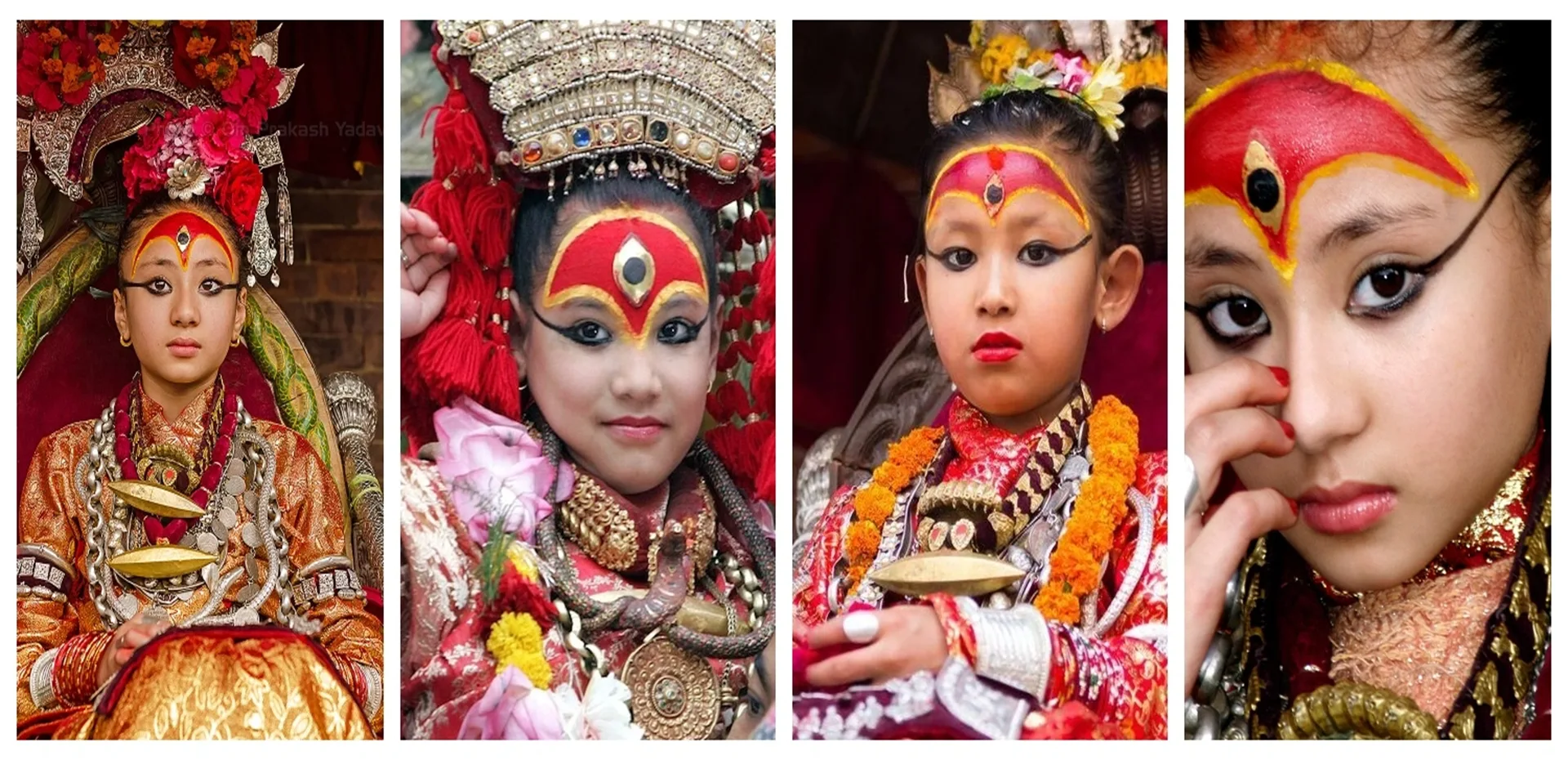
Several legends attempt to explain where Goddess Kumari of Nepal came from and how she came to be worshiped as a deity. Some groups of people tell and believe two stories about the King and Goddess Taleju.
The first story is about an old Malla king in Nepal named Jay Prakash Malla. People believe that the king and the goddess Taleju used to play Tripasa (dice game) in the king’s room. The Mallas had a clan god named Taleju. The goddess goes to the king’s room every night, and the king always keeps the meeting secret.
One night, the king’s wife followed the king to his room and watched him meet with the goddess Taleju behind closed doors. The goddess found out about the king’s wife and went away. Before she left, the Taleju goddess told the king that she would return as a young girl from Ratnawali’s Newari community.
To make amends with Goddess Taleju, Jaya Prakash Malla begins looking for children who possess the Taleju spirit. This is how the Kumari Goddess tradition began. Jaya Prakash also built a house for Kumari near the palace and called it “Kumari Ghar.”
King Trailokya is the center of a second story about where the Kumari Goddess came from. The myth says that every night, King Trailokya and Goddess Taleju played Tripasa and talked about how the country should be run. One night, Trailokya tried to get sexual with the goddess, which made her angry.
She went away as soon as the god saw what he was doing. Later, the king cried because he was sorry and begged not to do it again. When the goddess sees the king crying, she agrees to take the form of a Shakya family girl named Kumari. In Nepal, this is how the Kumari tradition began.
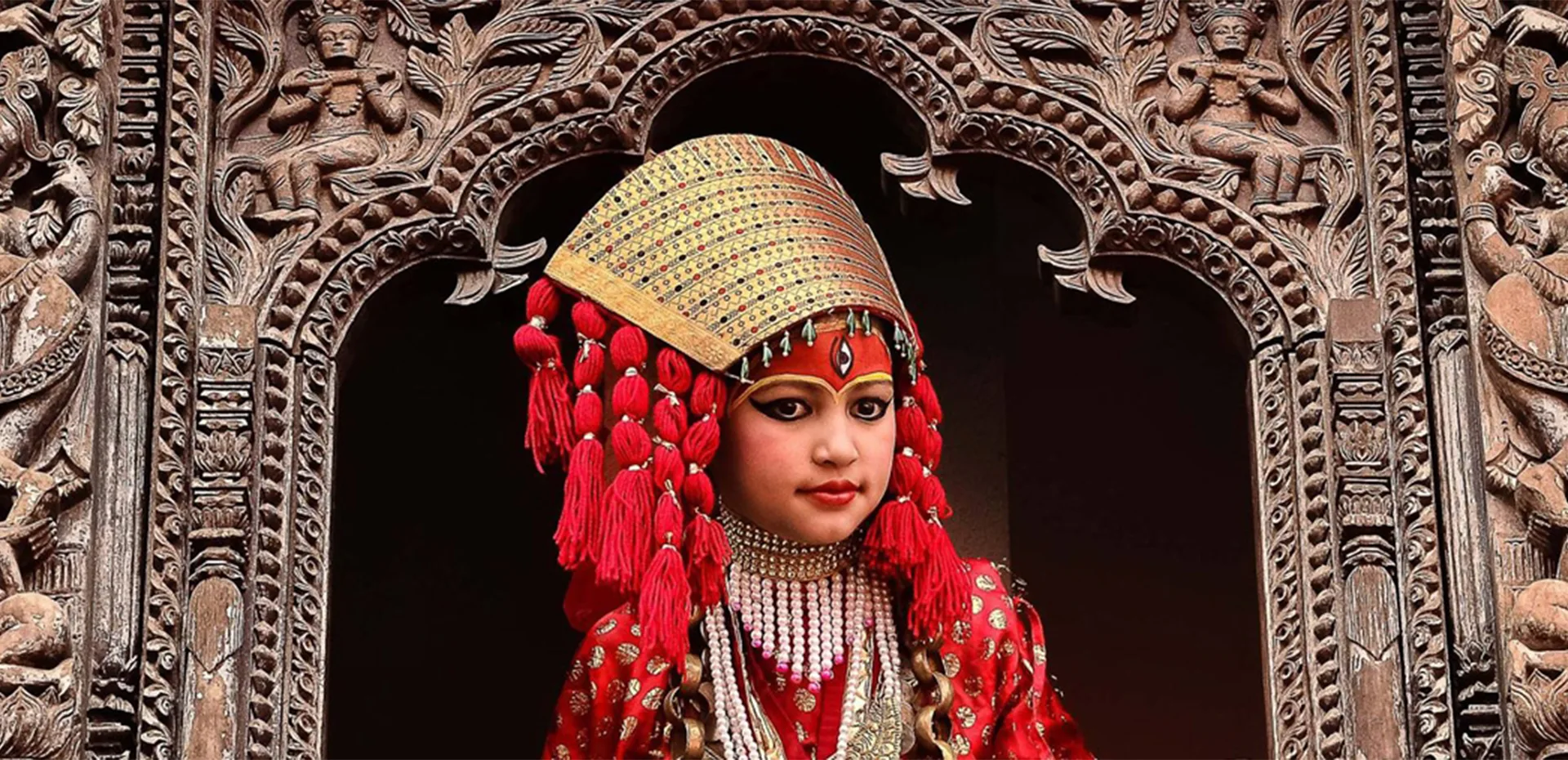
Selection Process of the Goddess Kumari of Nepal
The technique for locating a living goddess is difficult and involves numerous factors. The Kumari selection ritual is overseen by five senior Buddhist Bajracharyas, the Chief Royal Priest, the Priest of Taleju, and the royal astrologer.
The Initial Phase of the Selection
Some of the most important things that are looked at are a child’s health, whether or not they have scars or marks on their bodies, how healthy their skin is, whether or not they have periods, and whether or not they are missing teeth.
Before she can move on to the next tests, the girl must first show that she meets the basic requirements for the position of Kumari. One part of the test is to see if she has “batiis lakshan,” which means “the perfection of 32 body parts.” One example of a battis lakshan is the circular sitting position known as Padmasana. Other examples include the lion’s chest and the cow’s eyelashes.
She has to be just like the goddess, so she has to be calm and brave. The interpretation of her horoscope is performed using the same method. After that, the little girl is put through a very tough and difficult test to see if she is worthy of becoming the next living goddess of Nepal.
Next Phase of the Selection
On Kalratri (black night), an important night in the Hindu celebration of Dashain, 108 buffalo and goats are sacrificed to the goddess Kali. The girl is brought to the Taleju Bhawani temple, where masked men dance rhythmically in front of the candle-lit heads of the sacrificial animals. Those picked must demonstrate their bravery and boldness by taking risks and accomplishing difficult tasks.
But this step is not true 100% of the time. No one except the priest knows what goes on inside the room, and this process is hidden from everyone. Also, the Kumaris are too young to remember what she did to choose them. But many people think she is the real Durga, who loves blood, so the masked men only show her some animal blood to see how she reacts.
After she finishes all of her prior tasks, which also require remaining in that secret room, the last thing she needs to do is gather up the things left behind by the previous goddess. She will become the new living goddess of Nepal if she selects them appropriately from among the other items.
Choosing the new living god should be done before the end of October. The selection procedure can be different in different places. At last, a Goddess Kumari of Nepal is selected, and then she has to be made clear to become the goddess Taleju Bhawani’s face. Then, people take her to a special priest, where she goes through many secret Tantric rituals to clean her body of dirt. Once all the rituals and tests are done, Taleju Bhawani comes in and makes her the new Kumari.
Isolated life of Goddess Kumari of Nepal
The story of Nepal’s Goddess Kumari is interesting, and we like to hear it, but it’s not easy to keep a goddess alive. Typically, the selection of the Kumari goddess takes place at an early age, as young as two to three years. After the selection of Kumari, the children have to leave their parents and birth house until another living goddess in Nepal takes her place.
She cannot have any friends except the kids of her caretakers, who are from the same caste. The Kumari lives in Kumari Ghar (house), an old palace house with no modern amenities. Until lately, the Kumaris in Kumari Ghar had no idea how to read and write. Additionally, they were not allowed to use the internet. The Kumaris spend their days in a room with four walls and only a few candles and lamps for light. It is not easy to be the only living goddess in the world.
The Goddess Kumari of Nepal always has her hair in a topknot with a red ribbon and fragrant flowers tied around it. The Kumari is always seen with dramatic, attention-getting eye makeup, which makes her look very distinct from everyone else and has become a way to recognize her. Like her forehead, painted with vermilion, her feet are also decorated with red colorants (Ala). Ala is a traditional way for Newars to do pedicures. Goddess Kumari of Nepal doesn’t wear shoes, but you might see red stockings on her feet.
Her caretakers dress her up in beautiful red and gold for ceremonies. She wears a Jama (cloak) that goes all the way to her feet, a red Bhoto (T-shirt), and a red pagri (turban). “Agni Chakshu,” which means “Fire Eye,” is painted on her forehead. The “fire eye” symbolizes her ability to see things.
Visit in Kumari House
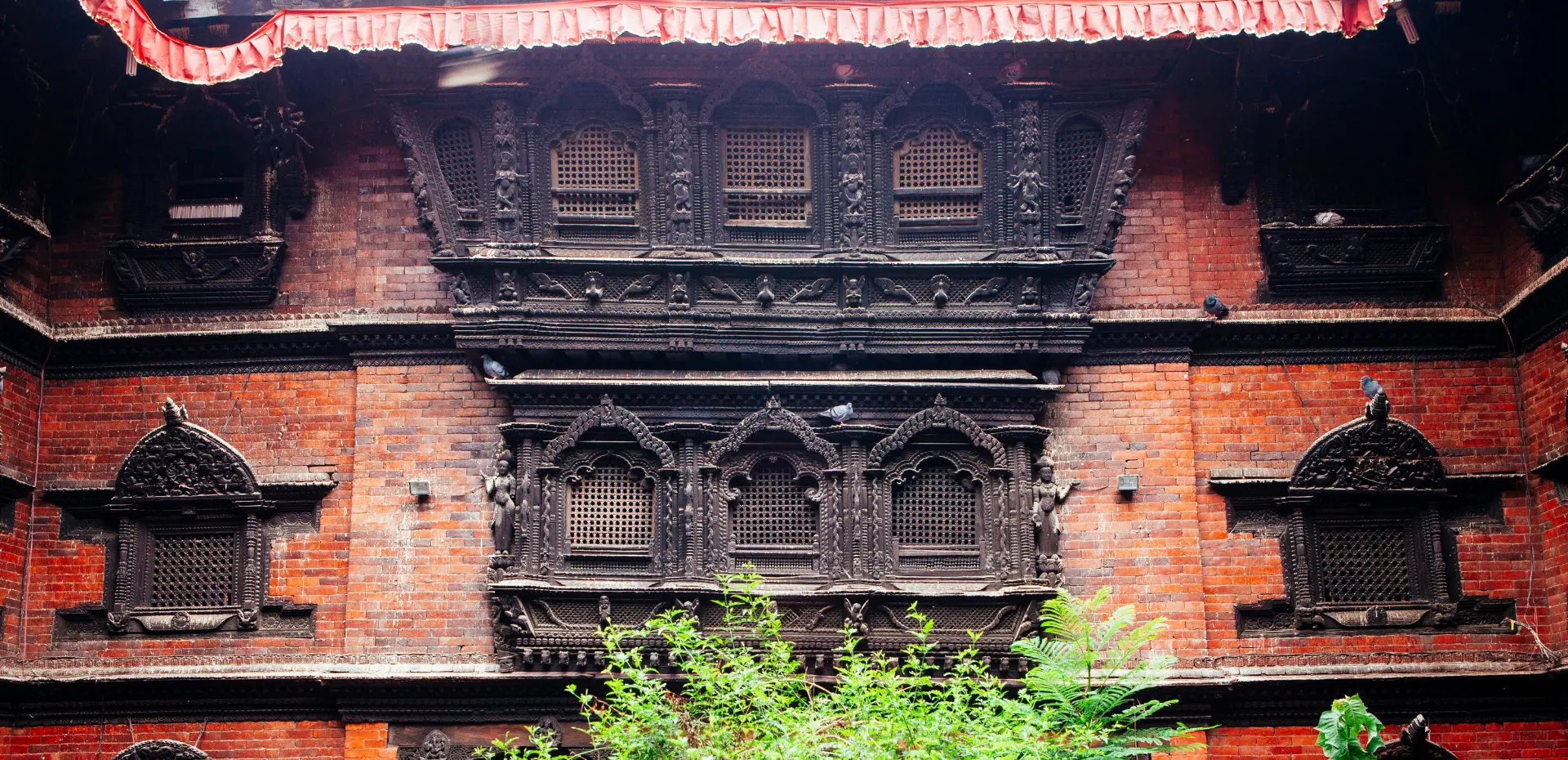
People stand outside that palace’s window for a long time, hoping to catch a glimpse of the living god. They think that just seeing the living god will bring good luck. People also believe that Kumari has special control over the illness. Many well-known people go to see her to ask for blessings and luck.
It has been believed that when someone visits, her actions are watched and analyzed to determine what will happen to the visitor. If she starts crying or laughing loudly, rubs her eyes, shakes, and takes the food offerings, the visitor is said to have bad luck. This could be a serious illness, a loss of money, or something else bad.
If you go to Nepal, you could also go to the Kathmandu Durbar Square area to see the small female deity. Only on special days, like Indra Jatra, is Goddess Kumari taken out of the house.
Is Kumari related to Indrajatra? – Indra Jatra Confusion with Kumari Jatra
Indra Jatra is the longest festival after Dashain in Nepal, mostly made up of people born and raised in Kathmandu. The festival lasts for eight days. On the first day, the lingo, a ceremonial pole, is set up. On the last day, the lingo is taken down.
As mentioned above, the Kumari goddess was close to the kings. But when she was angry, she stopped visiting. To make things right, the goddess instructed the king to find a young girl from the Shakya family in Kathmandu and make her the physical incarnation of Goddess Taleju.
King Jaya Prakash Malla believed that worshiping the goddess Kumari of Nepal with devotion would benefit the state and the people. He built a home for Kumari in Kathmandu and moved her there. On the day of Indra Jatra in 1756, he began the tradition of the Kumari chariot procession. Saying that the Kumari Jatra and the Indra Jatra are two different celebrations.
Kumari, the living goddess in Nepal, comes out of Kumari Ghar and blesses everyone. People feel fortunate enough to get the opportunity to see her.
The Kathmandu Valley is home to several chariot processions each year. Compared to other celebrations, Kumari Jatra is unique and begins and concludes in the same location, i.e., Basantapur Durbar Square.
Three days are set aside for the chariot parades.
- The first day’s route, the Kwaneyā, or “downtown procession,” starts in Basantapur and goes through Maru, Chikanmugal, Jaisidewal, Lagan, Brahma Marga, Wondé, Hyumat, Kohity, Bhimsensthan, Maru, and Basantapur again.
- The second day’s route, called Thaneyā, or “uptown procession,” starts in Basantapur and goes to Pyaphal-Yetkha-Nardevi-Tengal-Nhyokha-Nhyakan Tole-Asan-Kel Tole-Indra Chok-Makhan and then back to Basantapur.
- The third day’s route, or Nanichaya, or “midtown procession,” goes from Basantapur to Pyaphal-Yetkha-Nardevi-Kilagal-Bhedasing-Indra Chok-Makhan, and Basantapur again.
How does the Kumari Goddess lose her position?
The Goddess Kumari of Nepal is an incarnation of strength and safety. Kumari is the only Hindu or Buddhist figure who stands for purity. A Kumari must still be a child, and she shouldn’t have lost a single drop of blood. After the Kumari hits puberty and gets her first period, she is thought to be impure, and the search for a new Kumari begins.
If Goddess Kumari of Nepal loses blood, she turns back into a normal person and loses the power that the gods gave her. Even when the present Kumari gets cut and loses blood, she can sometimes lose her title.
After Kumari is dethroned, her family must worship her as a goddess for the next four days at her home. Only then can she go back to her normal life. Since she is no longer a goddess, she can walk independently, share food, have more friends, and do many other things.
When her time as a Kumari is over, she is treated like any other child. It might take some time for the ex-Kumari to get used to their new surroundings, which could be hard for them. After she is replaced, the government gives her a small pension every month as a token.
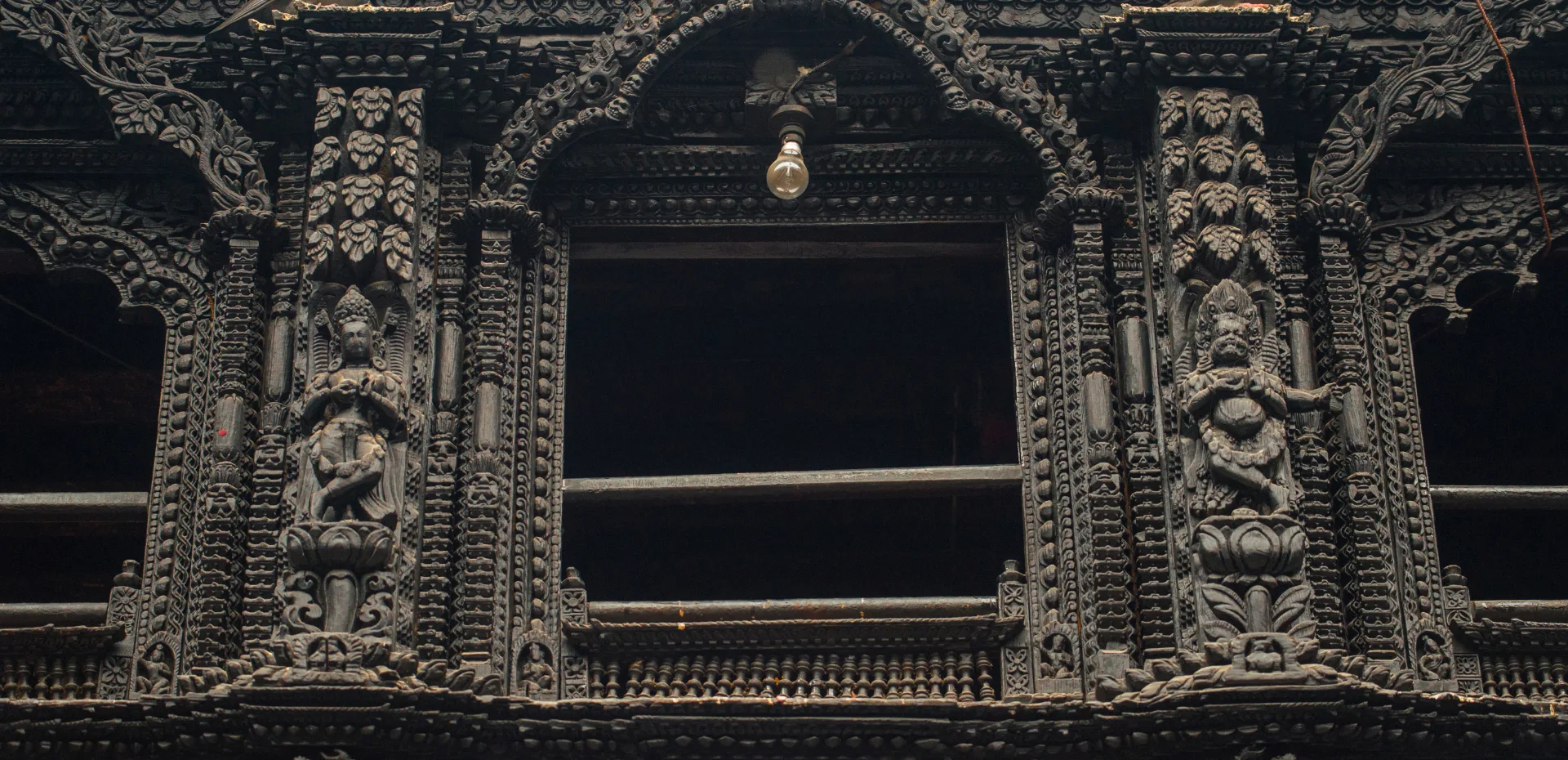
Human rights and children’s rights activists on the Kumari System
Child’s rights Nepal’s main agenda is separating girls from their families at a very young age, not giving them a good education, and not giving them a safe place to live. This makes them anti-social and makes it hard for them to fit in with society after losing their power.
Nepalese activists for human rights and children’s rights have recently discussed the Kumari system and put pressure on it. This has resulted in changes in the strictness with which the Kumaris of Kathmandu rule. Kumaris did not get the right education and information about their surroundings and social life. This made it harder for her to go from being a living goddess to just another person after she was dethroned.
Kumari now has a personally qualified teacher and gets an education at the Kumari house. Even books, the Internet, and magazines are available. The Kumari takes the national exams in the palace under supervision. After they lose the name of the “living goddess,” Kumari Goddess can step toward a better future.
International popularities of Goddess Kumari of Nepal
The story of Goddess Kumari of Nepal is widely discussed throughout the world. The audience’s reactions to the story’s twists and turns show a wide range of surprise, confusion, and curiosity. A wide variety of international media outlets have been covering the story.
- The Kumari was in the fourth episode of the second season of the CBS drama series “Madam Secretary,” which aired on October 25, 2015, and was called “Waiting for Taleju.” In the episode, the made-up US Secretary of State Elizabeth McCord meets with the Kumari to get support for a deal to help the US get money for disaster relief after the Nepal earthquake in April 2015.
- In the fourth episode of the Netflix limited series The Serpent, Monique witnesses a Kumari girl from outside the temple.
- In Diana Wynne Jones’s novel ‘The Lives of Christopher Chant,’ the character of the Living Asheth is a young girl adored as a goddess in one of the worlds visited by the narrator; she is based on the Kumari, who is the incarnation of a goddess and must follow strict rules of ritual purity.
- The female character of the Korean webtoon series “For the Sake of Sita” was a Kumari in Nepal.
Recent Former Goddesses: Kumari of Nepal
Nepal has many Kumaris, but they are not as well-known as the Royal Kumari. Other Kumaris come from places like Patan, Bungamati, and Bhaktapur, which are nearby.
Goddess Kumari of Kathmandu Valley
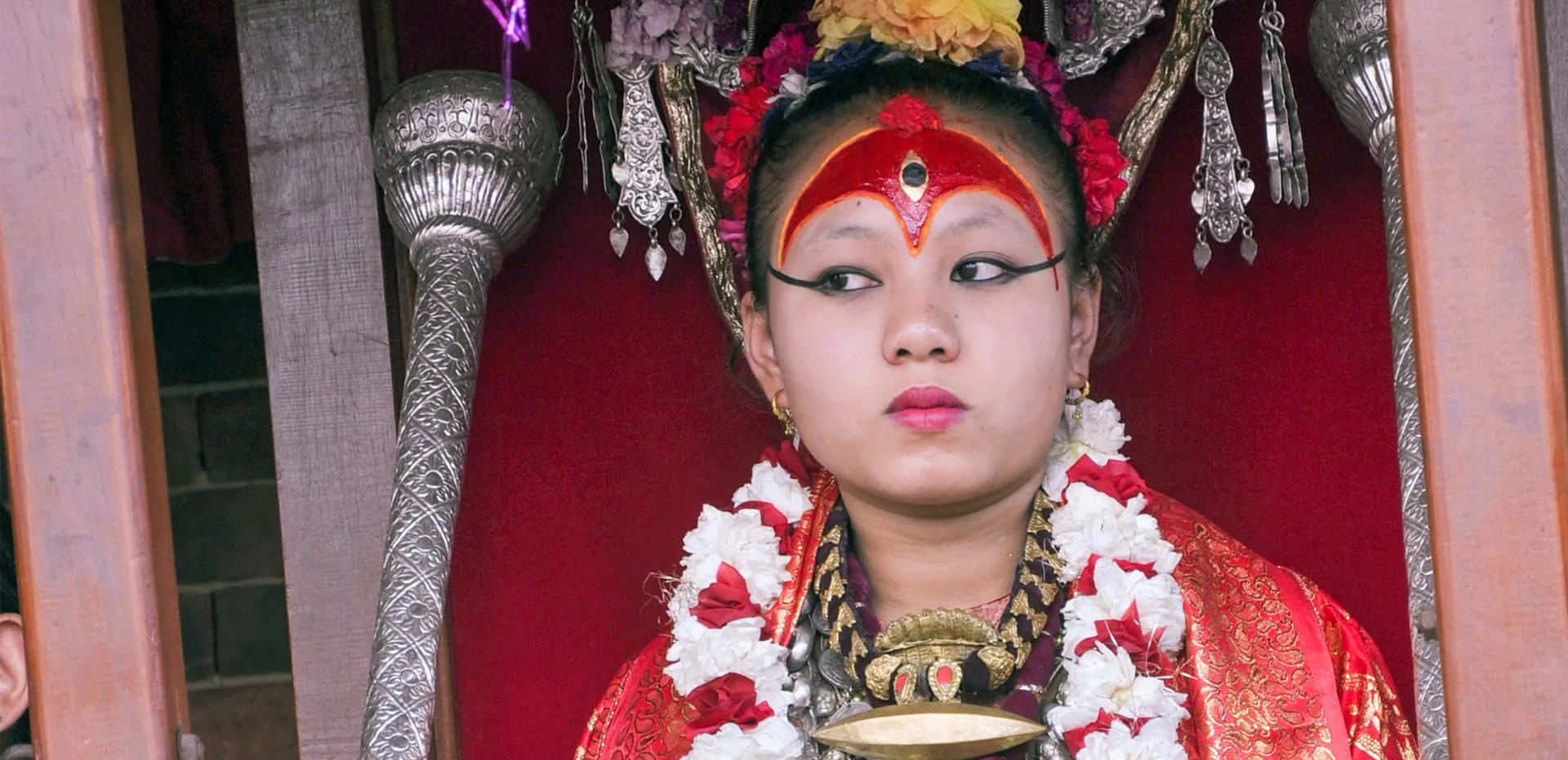
The former Royal Kumari is Trishna Sakhya, who was selected as a Goddess Kumari of Nepal on September 17, 2017, when she was only three years old. She is from Kathmandu and is formally known as the Living Goddess. She lives in Kathmandu Durbar Square and is thought to be the best Kumari in history. According to Kathmandu’s laws, the Kumari has to follow strict rules and restrictions. When she lives in the Kumari residence, she is cared for by a caretaker. For her academic education, a home teacher is assigned.
Goddess Kumari of Lalitpur Valley
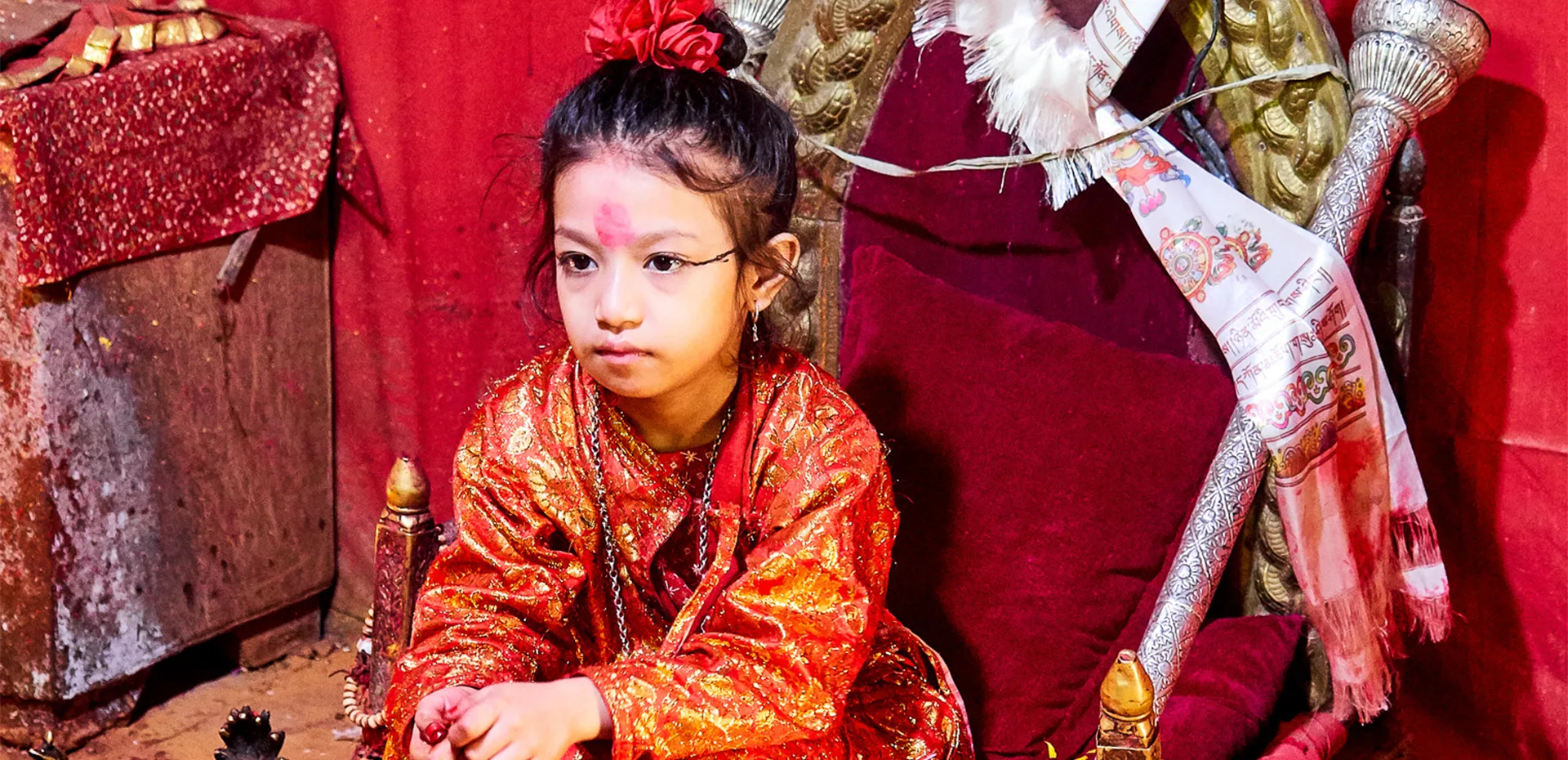
Nihira Bajracharya is the official Kumari of Patan; she was chosen as the Kumari of Patan at age five. She presently resides at Ratnakar Mahavihar (Temple of the Living Goddess Kumari of Nepal), where she was appointed Kumari in 2018.
Goddess Kumari of Bhaktapur Valley
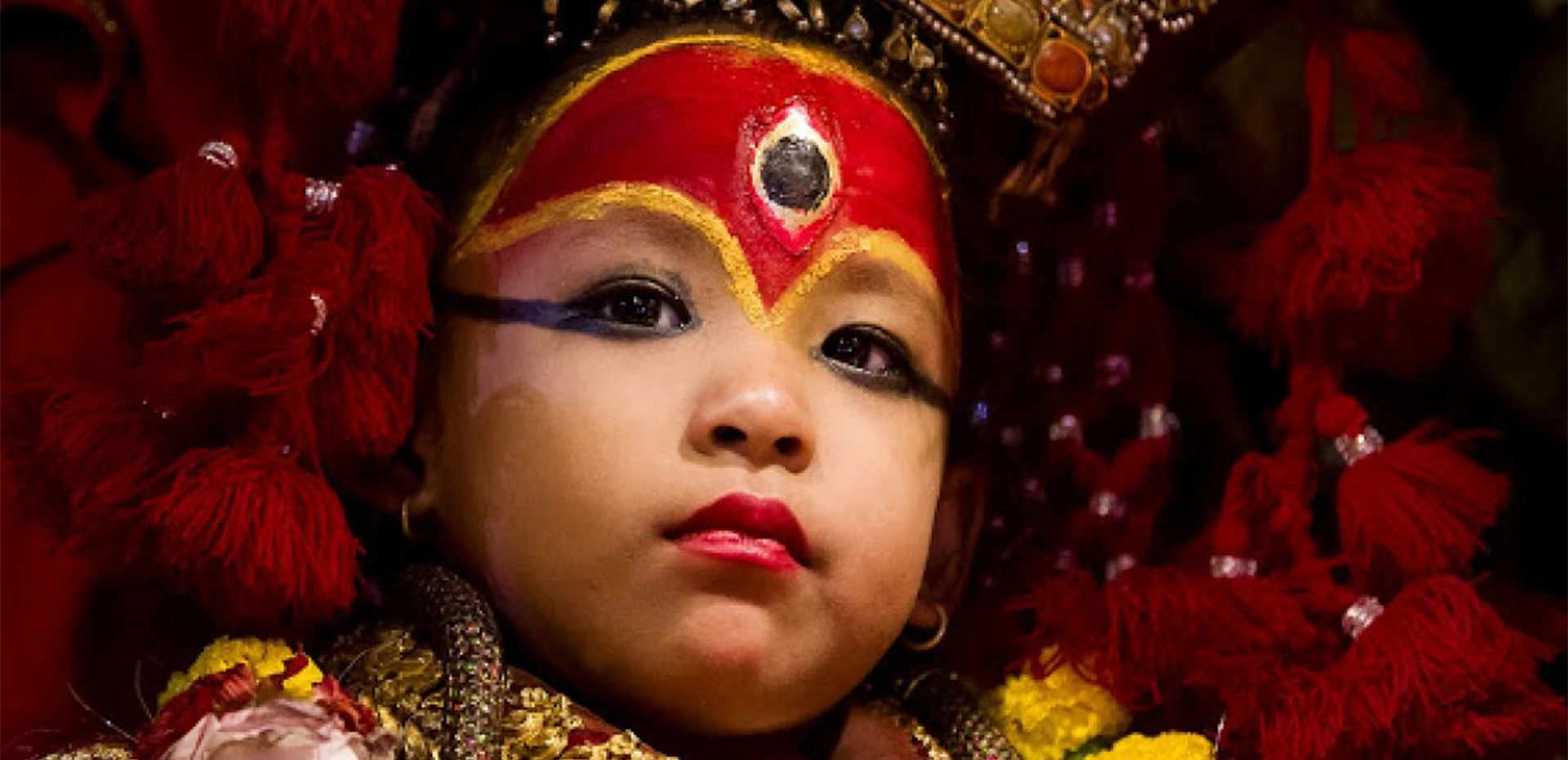
The former Kumari goddess of Bhaktapur (Khwopa) is Luniva Bajrachrya, also known as the Ekanta Kumari. Her reign as Kumari began in 2021, when she was only three years old. She got the name Ekanta Kumari because she used to rest her head on Taleju Bhawani’s lap.
Most Popular Question: Can a Goddess Kumari of Nepal marry?
Despite common belief, Kumari is suitable for marriage. It is often claimed and misunderstood that Kumari is unable to get married. It is said that if Kumari does get married, her husband will die soon after. People also say Kumari’s horoscope is extremely strong, causing problems in their marriage. These claims have not been proven as of yet.
Surprisingly, none of these incidents happened shortly after their marriages. Almost all ex-kumari are married without difficulty, and neither died soon after their marriages. According to one of the ex-kumari, it is simply a myth and has no impact on their marital status. In several interviews, you can find ex-kumaris’ happy marital evidence.
Dhana Kumari Bajracharya: The Lifelong Kumari of Patan Nepal
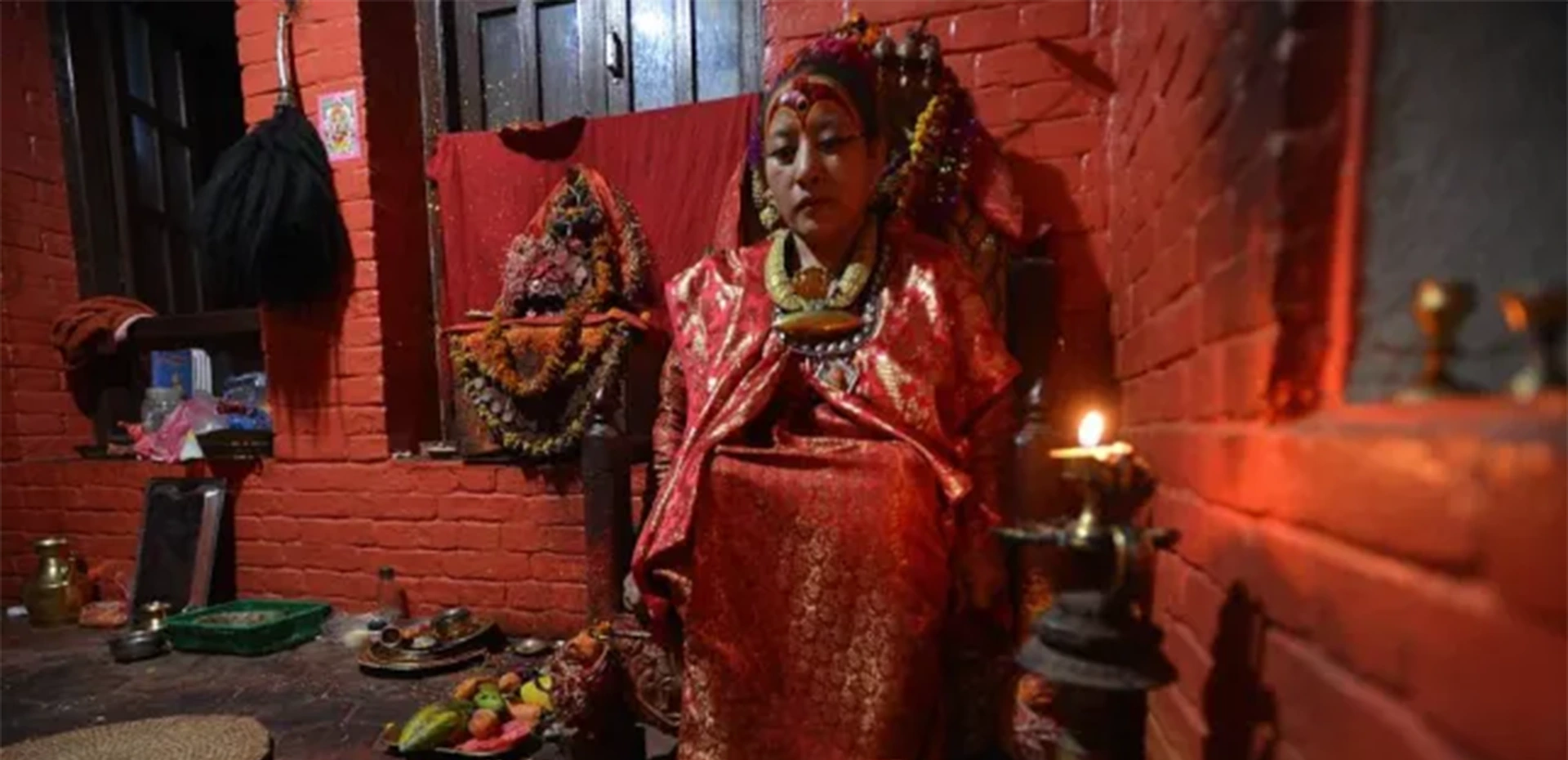
The kumari of Patan Durbar Square, Dhana Kumari Bajracharya, is the Kumari for life. She is 73 years old. Her followers think it is because of the divine power that she has never had her period.
The end of her reign was brought about by a scandal started by Nepal’s then-crown prince Dipendra in 1984. When the prince, then just 13 years old, met Bajracharya during a festival, he asked, “Why is she so old?” This prompted the priests to replace her with a young girl.
She said that they had “no need to replace me.” “I was feeling a bit irritated… My inner goddess appears to be alive and well.” Even though a newer, younger kumari replaced her, people still worship her as the goddess.
Every day she wakes up, combs her hair into a topknot, lines her eyes with kohl that curves upward to her temples, and dons an embroidered red skirt similar to the one she wore throughout her time as a kumari.
In 2001, Bajracharya’s niece Chanira was given the honor of becoming a kumari, and Bajracharya assisted her throughout the process.
Dhana Kumari has been doing everything she had to do as a Kumari. When a big earthquake hit Nepal in April 2015, the rule said that the country’s longest-serving “living goddess” had to do the unimaginable: walk on the streets for the first time in her lifetime.
Chanira says that since the earthquake, she has devoted most of her time to praying. “It made her feel very sad… Last year, our astrologer told us that my aunt would leave the house. We did not know how that would happen,” she said. “But we did not expect this to happen.”
Frequently Asked Questions (FAQs)
Who is the Kumari Goddess of Nepal?
Kumari, or the Living Goddess, is the Dharmic religious tradition of worshiping a chosen girl as the manifestation of the divine female energy, or Shakti.
Who is the former Royal Kumari of Nepal?
Trishna Shakya is the official Royal Kumari of Nepal as of 2023. She was chosen when she was only three years old. In 2017, she took the place of Matina Shakya as the Royal Kumari.
Can a Kumari walk?
The Kumari’s feet will not touch the ground again until the goddess leaves her body. When she leaves her palace from now on, she will be carried or taken somewhere in her golden palanquin. Like the rest of her, her feet are now holy. Or else there will be a person to carry her.
What type of power does Kumari possess?
Goddess Kumari of Nepal is thought to have the power to bring people luck and wealth, and even a glimpse of her is thought to do this.


